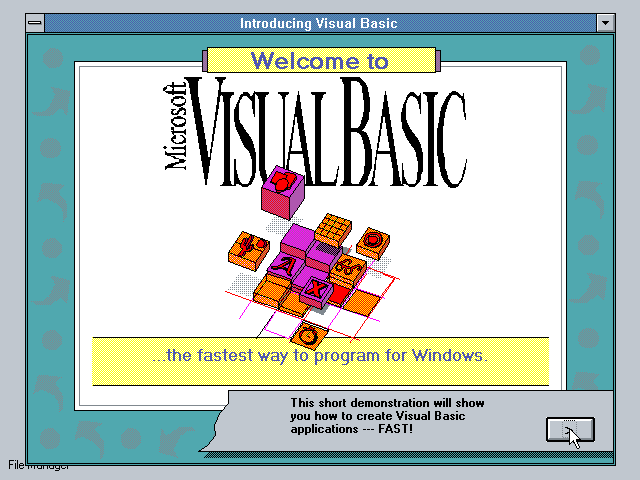

The programming environment was easier to use than the 1.0 version, and it was more fast. The interface uses a Text user interface, using extended ASCII characters to simulate the appearance of a Graphical user interface. This was because the language was actually the next version of Microsoft's DOS-based BASIC compilers, QuickBASIC and BASIC Professional Development System. This version of the language itself was not quite compatible with Visual Basic for Windows. This version was first released at the Comdex/Windows World trade show in Atlanta, Georgia. Versions of Visual Basic are listed below: Name Ruby also provided the ability to load dynamic link libraries containing additional controls (then called "gizmos"), which later became the Visual Basic Extension (VBX) interface.

The Ruby interface generator provided the "visual" part of Visual Basic and this was combined with the "EB" Embedded BASIC engine designed for Microsoft's abandoned "Omega" database system. Microsoft decided to combine Ruby with the Basic language to create Visual Basic. Tripod did not include a programming language at all. Microsoft contracted with Cooper and his associates to develop Tripod into a programmable form system for Windows 3.0, under the code name Ruby (no relation to the Ruby programming language). The drag and drop design for creating the user interface is derived from a prototype form generator developed by Alan Cooper and his company called Tripod. Private Sub Form_Load () MsgBox "Hello, World" End Sub History Many companies offered third party controls greatly extending its functionality. Though the program has received criticism for its faults, Visual Basic was a runaway commercial success since its release for version 3 in the summer of 1993. Visual Basic will not run on operating systems other than Windows and on machines with non- Intel compatible processors. VB also includes advanced features - concepts and structures which allow programs to be adapted for use with the Internet. The language allows a beginning programmer to produce professional-looking Windows applications, as it includes drawing tools to create normal Windows forms. exe file so that it will run on all modern Windows computers, whether VB is installed or not. Once the code is working, it can be compiled into an. Having an interpreter makes it simpler to use, as there is no need for the computer to compile the code, possibly finding errors to fix, before the compiled version can be run. It is an interpreted language, code can be run immediately after being written. Visual Basic is a widely understood high-level programming language, written using simple English-like words and syntax. The BASIC language is said to be easier to read than other languages. Visual Basic (VB) is a programming language developed by Microsoft for their operating system Windows.


 0 kommentar(er)
0 kommentar(er)
